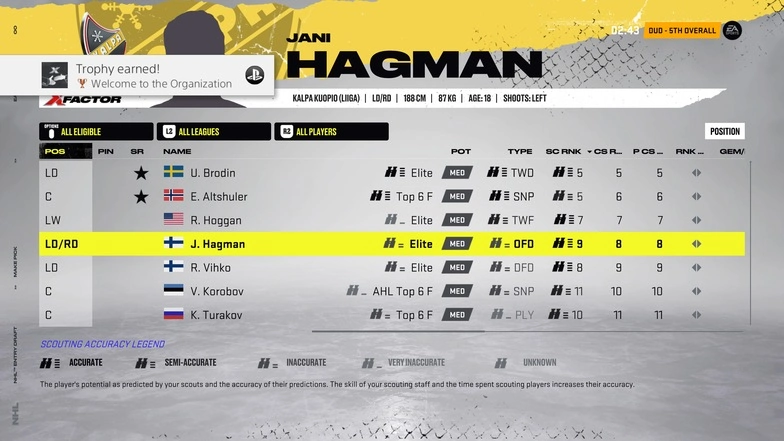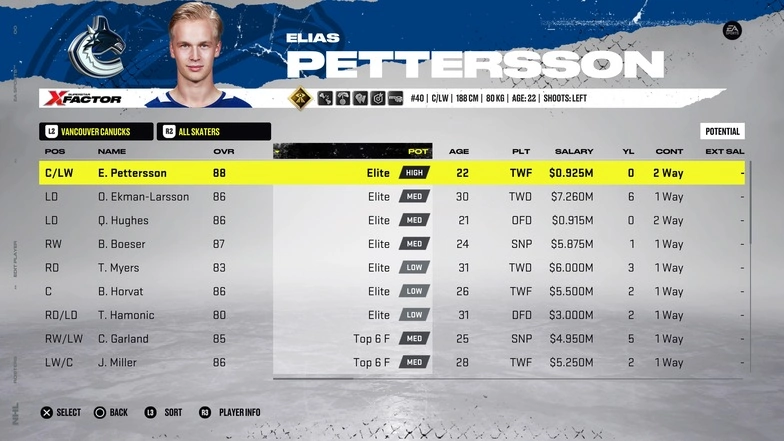NHL 22: The complete guide to Franchise mode potential
NHL 22 has started, and players are the most valuable aspect of the game. For many players, the player's value and the player's potential are very worthy of concern. But for many new players to understand and use the player's potential to determine the best NHL 22 player. Many players try to solve this problem based on their intuition, This is not only a waste of time, NHL Coins but also the final result is often not ideal. Therefore, in this article, a detailed guide is made on the potential of the NHL 22 franchise mode.
NHL 22: Player Potential Explain

Player potential refers to the expected upper limit of the player and his accuracy/probability level to reach the upper limit.
There are nine possible levels in the game:
- Franchise: Talent for generations. You can build the entire franchise around it.
- Elite: one of the best players in the league
- Top 6 F: Forwards used in the first or second row
- Top 9 F: Forward used in the first, second, or third row
- Top 4 D: Defenders used on your first or second line
- Top 6 D: Defenders used by Line 1, Line 2, or Line 3
- Bottom 6: Players that will be used in your 3rd or 4th row
- AHL top 6: AHL's first-line or second-line players
- AHL Bottom 6: The 3rd or 4th line player in the AHL
And there are four levels of accuracy:
- Accuracy: Scouts determine the player's potential
- High: It is very likely that the detected potential is accurate
- Med: Scouts are neither certain nor certain about the player's potential
- Low: Scouts are uncertain about the player's potential
You can think of these accuracy levels as variance or the range of possibilities you can expect. For example, after drafting and development, a senior top 6 F player may become a top 9 F or elite forward (+/- 1 difference). On the other hand, Med Top 9 F players have a wider range of possibilities. He can be an elite player or the last six players (the difference is +/- 2).
Here, we also need to separate the scout label from the development potential. Although these two things look the same, they are used in different ways.
The scout tag is used to identify the most talented players before the draft. They show you the quality of the scout report, not the actual potential of the player. Once the player joins your team, you will see their development potential.
NHL 22: Can players change the potential tiers?

Once you have selected a player and reviewed his actual development potential, there is still room for change. Although the initial development potential is usually quite accurate, things such as playing time and roles often impact.
Similarly, when considering the upper limit of the player, you should keep in mind the accuracy of the development potential.
Therefore, players with high development potential and high accuracy are likely to develop steadily and realize their potential. Although "much better" situations are rare, players with Med accuracy may be much better or worse than initially thought. Nevertheless, you can still see the young Med Top 6 F players become elite players or fall behind completely.
NHL 22: All players with franchise rights and elite potential list
Finally, here is a list of all current players with the highest ratings. I will focus on young players because I think everyone's goal is to work hard for the future.
There are a few young players with the franchise or elite high potential in NHL 22:
| Position | Name | Current Team | OVR | Potential |
| C/RW | Nathan Mackinnon | Avalanche | 93 | Franchise High |
| C/LW | Leon Draisaitl | Oilers | 93 | Franchise Med |
| C | Connor McDavid | Oilers | 95 | Franchise Med |
| C | Auston Matthews | Maple Leafs | 92 | Franchise Med |
| C/RW | Sam Reinhart | Panthers | 85 | Elite High |
| C | Jack Hughes | Devils | 84 | Elite High |
| LW | Lexis Lafreniere | Rangers | 82 | Elite High |
| C/LW | Elias Petterson | Canucks | 88 | Elite High |
Here are all other young players with Elite Med potential, in no particular order:
- Jamie Drysdale
- Trevor Zegras
- Jakob Chychrun
- David Pastrnak
- Charlie McAvoy
- Jack Eichel
- Rasmus Dahlin
- Dylan Cozens
- Matthew Tkachuk
- Martin Necas
- Andrei Svechnikov
- Sebastian Aho
- Alex DeBrincat
- Cale Makar
- Bowen Byram
- Alex Newhook
- Mikko Rantanen
- Adam Boqvist
- Patrik Laine
- Denis Gurianov
- Miro Heiskanen
- Dylan Larkin
- Filip Zadina
- Aaron Ekblad
- Quinton Byfield
- Kiril Kaprizov
- Nick Suzuki
- Cole Caufield
- Eeli Tolivanen
- Jack Hughes
- Nico Hischier
- Matthew Barzal
- Adam Fox
- Kaapo Kakko
- Thomas Chabot
- Tim Stützle
- Erik Brännström
- Brady Tkachuk
- Ivan Provorov
- Haydn Fleury
- Mikhail Sergachev
- Brayden Point
- Mitchell Marner
- William Nylander
- Quinn Hughes
- Brock Boeser
Conclusion:
If you want to build a successful dynasty, the player potential in the NHL 22 franchise mode is one of the most important aspects of the game you need to master. After all, seizing the opportunity of one or two players is not the worst thing in the world. I like to try my luck with the top 6 players in the low or middle positions instead of pursuing high-end players all the time. You will find these players easier to find, and it will be more rewarding to develop them into superstars.